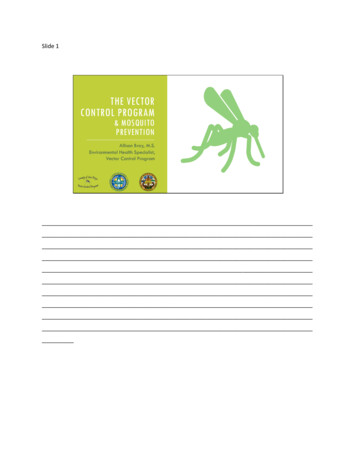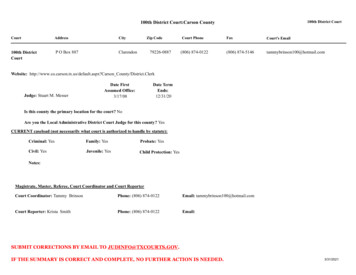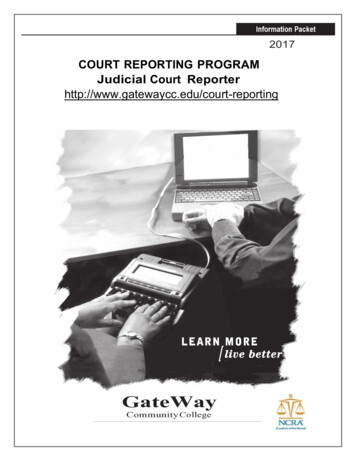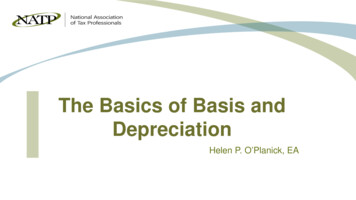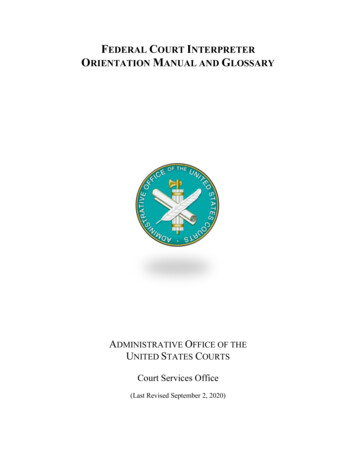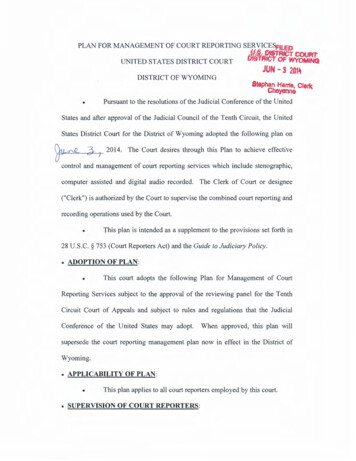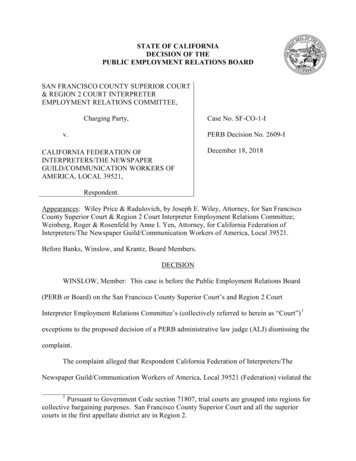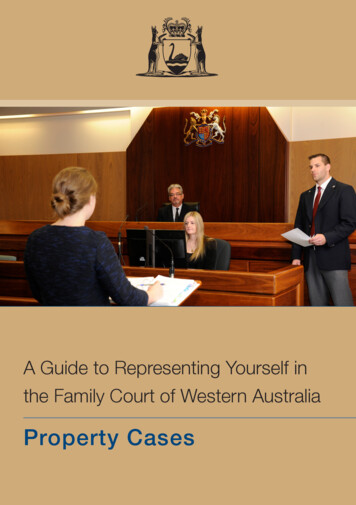
Transcription
A GUIDE TO REPRESENTING YOURSELF IN THE FAMILY COURT OF WESTERN AUSTRALIA – PROPERTY CASESA Guide to Representing Yourself inthe Family Court of Western AustraliaProperty Cases
A GUIDE TO REPRESENTING YOURSELF IN THE FAMILY COURT OF WESTERN AUSTRALIA – PROPERTY CASESDisclaimer1.The information contained in this guide is provided in good faith. However, the accuracy of theinformation cannot be guaranteed, as there may have been changes to the law since the guidewas prepared.2.The State of Western Australia, the Family Court of Western Australia and their employees andagents expressly disclaim any liability whatsoever to any person for any loss or damage arising,whether directly or indirectly, and whether or not as a consequence of negligence, from thecontents or the use of this guide.3.This guide has been prepared as a general guide. It is not a substitute for obtaining professionallegal advice specific to your particular circumstances. “A guide to representing yourself in the Family Court of Western Australia”FAMILY COURT OF WESTERN AUSTRALIA 2000Revised December 2015Please check the Family Court of Western Australia website www.familycourt.wa.gov.au for latestupdates and/or revisions.
A GUIDE TO REPRESENTING YOURSELF IN THE FAMILY COURT OF WESTERN AUSTRALIA – PROPERTY CASESForewordMany people are unable to afford a lawyer to help them to resolve family disputes.They can be at a disadvantage because the law is complicated and courtprocesses are sometimes difficult to understand.This guide is designed to help those people who do not have a lawyer to presenttheir cases in the Family Court of Western Australia. It is not a substitute forcompetent legal advice, but it is hoped the information provided will make it easierfor you to navigate through the court system.Judges and magistrates must always remain impartial and not appear to help oneside of a dispute to the disadvantage of the other. Although the judge or magistratecan provide some assistance, it is expected that each party who does not have alawyer will have tried their best to become familiar with this guide before coming tocourt.The court has received much positive feedback about earlier editions of the guide.We would appreciate hearing from you about any way you feel that future editionsmight be improved.Thanks are due to many people who have contributed to the new edition of thisguide, including Principal Registrar David Monaghan, Acting Magistrate LauraDe Maio, Registrar Leonie Forrest, Senior Research Officer Prue Hawkins, and myLegal Associates Kate Hesford and Kelly Merris.Stephen ThackrayChief JudgeFamily Court of Western Australia
A GUIDE TO REPRESENTING YOURSELF IN THE FAMILY COURT OF WESTERN AUSTRALIA – PROPERTY CASESImportant – Do I need a lawyer?You may be at a disadvantage if you represent yourself, especially if the other partyhas a lawyer. The judicial officer must decide a case on the evidence presented byboth sides. The judicial officer can question you, the other party and the witnessesabout evidence, but is limited in the help that he or she can provide.It is recommended that you are represented by a lawyer at trial. If that is notpossible, you should at least try to obtain advice from a lawyer about your case atthe earliest possible stage (see Where can I go for advice).
A GUIDE TO REPRESENTING YOURSELF IN THE FAMILY COURT OF WESTERN AUSTRALIA – PROPERTY CASESContents1. Introduction. 1What is this guide for?. 1The relevant legislation. 22. About the court. 3How to contact the Family Court . 3Personal safety. 3Interpreters. 3Attending by electronic communication. 4How does the Family Court contact me?. 4What should I wear to court?. 4What should I take with me to court? . 4Who can come to court with me?. 5What time should I get to court?. 5How should I behave in court?. 63. The relevant law for property settlement. 7Step 1 - Identifying and valuing the property. 7Step 2 - Contributions. 8Step 3 - Further adjustment. 9Spousal maintenance. 94. Preparation for trial. 10Affidavits. 10Disclosure. 11Service. 12What orders do I want the court to make?. 13Getting witnesses to attend trial. 13Joint schedule of assets and liabilities. 15Papers for the judicial officer. 15
A GUIDE TO REPRESENTING YOURSELF IN THE FAMILY COURT OF WESTERN AUSTRALIA – PROPERTY CASES5. When will my trial be held?. 17The readiness hearing. 17Callover. 18What if we reach an agreement after the trial date is set?. 196. What happens during the trial? . 20Order of proceedings. 20Opening address or statement . 21How do I give my own evidence? . 21Calling witnesses and their evidence . 22How do I cross-examine a witness? . 23How do I re-examine a witness? . 24Closing address or statement. 247. When is judgment given?. 258. Where can I go for advice?. 269. Legal information on the internet. 27Appendix A - Contributions. 28Appendix B - Matters to be taken into account. 30Appendix C - Attendance by electronic communication. 32Appendix D - De facto relationships. 34Guide to legal terms. 35
A GUIDE TO REPRESENTING YOURSELF IN THE FAMILY COURT OF WESTERN AUSTRALIA – PROPERTY CASES1. IntroductionWhat is this guide for?This guide is not intended to be a substitutefor professional legal advice.This guide is intended for people representing themselves at trial in property cases. It will providea brief overview of the court process and the relevant law. However, the focus will be on how toprepare your matter for trial, and the trial process itself.There is a separate guide for people representing themselves at trial in parenting cases. If your caseinvolves both children’s issues and property issues, the court process will be as set out in this guidefor your property orders only, unless you choose to have your property case dealt with as a childrelated proceeding and both parties agree.Other materials dealing with the earlier stages of proceedings are available from the Registry oronline at www.familycourt.wa.gov.au. For example, if you are about to commence proceedingsor are responding to an application, there are kits and brochures which outline how to prepare oroppose an application to the court. There are also brochures available on court procedures duringthe resolution stage of the application, such as the conciliation conference. (Note: Procedures incountry areas may be different.)If you have not yet filed an application or been served with an application, you should contact theFamily Relationship Advice Line or one of the other organisations listed under Where can I go foradvice.There is a Guide to legal terms at the back, which provides some useful definitions.1
A GUIDE TO REPRESENTING YOURSELF IN THE FAMILY COURT OF WESTERN AUSTRALIA – PROPERTY CASESThe relevant legislationIf the parties were or are married, the relevant legislation is the Family Law Act 1975 (Cth). If theparties were in a de facto relationship, the Family Court Act 1997 (WA) applies. You can only bringan application for property orders in relation to a de facto relationship in certain circumstances (seeAppendix D).Important sections from these Acts are set out in the appendices to this guide. To access the fulltext of the Acts go to www.comlaw.gov.au (Family Law Act 1975 (Cth)) or www.slp.wa.gov.au(Family Court Act 1997 (WA)).Various rules and regulations have been made under the two Acts, such as the Family Law Rules2004 (Cth) and the Family Court Rules 1998 (WA). These can be accessed in full-text on the samewebsites as above, under the heading “legislative instruments” or “subsidiary legislation”.The court also issues Case Management Guidelines and Practice Directions, which give guidanceabout practice and procedure in the Family Court of Western Australia and the Magistrates Court ofWestern Australia. These are available from our website.2
A GUIDE TO REPRESENTING YOURSELF IN THE FAMILY COURT OF WESTERN AUSTRALIA – PROPERTY CASES2. About the CourtYour case will be heard in the Family Court of Western Australia by a judge, or in the MagistratesCourt of Western Australia by a family law magistrate. The two courts work closely together in thesame building and cases move seamlessly between them.How to contact the Family CourtYou should address any correspondence to:The Principal RegistrarFamily Court of Western AustraliaGPO Box 9991PERTH WA 6848Facsimile: (08) 9224 8360Note: You must send each other party a copy of any correspondence you send to the court.Personal safetyThe Family Court has a Family Violence Policy, which can be downloaded from our website.If you are concerned about your physical safety or the safety of one of your witnesses, you shouldnotify the Principal Registrar in writing using the template letter on our website, preferably at least14 days prior to your court attendance. Despite the note above, it is not necessary for you to senda copy of this particular letter to the other party.You may wish to consider attending court by telephone or video link. If you become concerned foryour safety whilst in the court building, please inform court staff as soon as possible.InterpretersIf you, or a witness, need an interpreter, please contact the court as soon as possible after yourapplication or response is filed to make the appropriate arrangements.3
A GUIDE TO REPRESENTING YOURSELF IN THE FAMILY COURT OF WESTERN AUSTRALIA – PROPERTY CASESAttending by electronic communicationThe Family Court has facilities available for people to attend court by electronic communication,such as telephone or video link.If you need to use these facilities to attend a court event, you must write to the court atleast seven days before to ask permission, and lodge a Request to Attend by ElectronicCommunication form.However, if you need to use these facilities at a trial, you should tell the judicial officer at thereadiness hearing and, unless ordered otherwise, you must make an application to the courtat least 28 days before the trial (Application in a Case – Form 2 and an affidavit in support).Specific information (see Appendix C) must be included when seeking permission to attend a trialby electronic communication.The court may order that one or both of the parties pay the cost of using the facilities.If you attend court by telephone or video link, make sure that you are in a quiet place, away fromdistractions.For more information on the court’s facilities for electronic communication, ask at the Registry.How does the Family Court contact me?You must always let the court know your current contact address and telephone number.If you change your contact address or telephone number before your case is finished, you must fileand serve a new Notice of Address for Service – Form 8. If you do not let the court know yourcurrent contact details, you may miss important communications and your next court event mayproceed without you.What should I wear to court?You should dress comfortably. The minimum standard of dress is neat casual, which includesappropriate footwear. No hats or sunglasses should be worn in the courtroom.What should I take with me to court? Copies of all documents that: You have filed and served. You have received from the other party during the proceedings. Have been provided to you by the court.These should be organised so that you can find any document easily.4
A GUIDE TO REPRESENTING YOURSELF IN THE FAMILY COURT OF WESTERN AUSTRALIA – PROPERTY CASES Any other documents that you want to use, such as a document to put to a witness in crossexamination. All of the documents you have disclosed and all disclosure documents you have received fromany other party. Pens and paper. This guide.Who can come to court with me?You can bring people to the court to support you, but they might be asked to wait outside thecourtroom. If your support people and witnesses are inside the courtroom, they should sit in thegallery at the back. Hearings are open to the public unless the judicial officer orders otherwise.Conferences, including conciliation conferences, are held in a conference room and can only beattended by the parties, their legal representatives and court staff.Persons under 18 years of age are not allowed in the courtroom without permission from thejudicial officer. The court has a child-minding service between certain hours. For more informationabout this service, see our website.During a trial, the judicial officer will usually make an order requiring all witnesses to remain out ofthe courtroom until they have given their evidence. You or the other party can request that such anorder be made. Once the witness has given their evidence, they may remain in the courtroom forthe remainder of the trial.What time should I get to court?You should be ready and waiting at the Family Court at least 15 minutes before your listed time.If you have not attended the Family Court previously, it is advisable to allow plenty of time to secureparking and locate the relevant courtroom. Cases may be heard in another court building near theFamily Court.When you arrive, you should go to the reception desk on the floor where your case is listed to beheld and report to the court officer at the desk. All cases listed each day are displayed on electronicnoticeboards around the court.Your case might not be called until after the time it was listed, so make sure you are able to remainat court until your case has been heard.5
A GUIDE TO REPRESENTING YOURSELF IN THE FAMILY COURT OF WESTERN AUSTRALIA – PROPERTY CASESHow should I behave in court? If you are the applicant, you sit behind the right hand microphone. The respondent sits on theleft. If an Independent Children’s Lawyer has been appointed in your case, they will sit at thecentre microphone. When the judicial officer enters the court, you should stand and remain standing until told tobe seated by the court officer. You should bow your head slightly to the judicial officer as they take their seat at the bench.If you need to enter or exit the courtroom, it is a courtesy to briefly bow towards the judicialofficer if they are present. You should call the judicial officer “your Honour”, “Sir” or “Ma’am”. If you are referring to a judicial officer when speaking to a witness, refer to the judicial officer as“his Honour” or “her Honour”. Do not speak when the judicial officer is speaking. You should stand when speaking to the judicial officer, unless you have been advised it isacceptable to remain seated while speaking. Only one of the parties should be speaking atone time. You should also stand when you are examining or cross-examining a witness. When you are speaking, remain behind your microphone. The microphones are used to recordthe proceedings. They do not magnify your voice, so try to speak in a manner that is clear andprecise so everyone in the courtroom can hear you. If you want to show a document to a witness or the judicial officer, say so and hold it out forthe court officer to take it to them. Do not interrupt the other party (unless you are engaging in cross-examination, in which caseyou may interrupt if they are not answering the question you have asked or are giving evidencethat you consider is legally inadmissible). No food or drink is allowed (including chewing gum). Water is usually provided. Mobile telephones and pagers must be switched off, not placed on silent, because they mayinterfere with the recording of the proceedings. If you need to refer to your telephone for somepurpose in the hearing, you must ask permission from the judicial officer. A court officer may be able to help if you have questions about what to do, but they are notlegally trained and cannot give you legal advice.6
A GUIDE TO REPRESENTING YOURSELF IN THE FAMILY COURT OF WESTERN AUSTRALIA – PROPERTY CASES3. The relevant law for property settlementThe relevant law to be applied in applications for property orders is set out in Part VIII of the FamilyLaw Act 1975 (Cth) (“FLA”) if the parties were or are married, or Part 5A of the Family CourtAct 1997 (WA) (“FCA”) if the parties were in a de facto relationship. The intention of a propertysettlement is to end the financial relationship between the parties.A judicial officer can only make a property settlement order if they are satisfied in all thecircumstances that it is just and equitable to do so. Property settlement applications are oftendetermined by following this four-step process:1.Identify and value the assets and liabilities of the parties, and their legal and equitable interestsin that property.2.Assess the contributions made by each party and decide what percentage of the propertyeach party should receive based on these contributions.3.Make any further adjustment after considering various matters including the parties’ futureneeds.4.Determine whether the proposed orders are just and equitable.Your affidavit evidence is very important in assisting the judicial officer to deal with the first threesteps.Step 1 – Identifying and valuing the propertyThe judicial officer needs to identify and value the assets, liabilities and financial resources held bythe parties as at the time of trial.Each party is required to file a Financial Statement – Form 13, which is available from the Registryor online. The Financial Statement is an affidavit, so you must swear or affirm that its contents aretrue. A Financial Statement Kit is available from the Registry or online.Property can include real estate, furniture, cars, boats, money, businesses and shares, amongstother things.Superannuation is also taken into account, but the way this is done may differ depending onwhether you were married or in a de facto relationship. A Superannuation Information Kit isavailable from the Registry or online.The judicial officer must take into account all property in which the parties have an interest.This includes property that is held in one party’s name or in joint names; property held in trusts,companies or other entities; and property that is located interstate or overseas.7
A GUIDE TO REPRESENTING YOURSELF IN THE FAMILY COURT OF WESTERN AUSTRALIA – PROPERTY CASESThe judicial officer will normally require evidence of the value of all the property as at the time of thetrial. If you and the other party cannot agree on the value of an item of property, a qualified valuershould value it (see Expert witnesses). The valuer needs to provide an affidavit attaching theirvaluation report. “Market appraisals” are usually not admissible as evidence of value.The court must also consider any “financial resources”. The concept is difficult to explain, and ifyou are in any doubt about its relevance you should seek legal advice. In general terms, a “financialresource” is something of actual or potential value which cannot presently be treated as an item ofproperty.Step 2 – ContributionsOnce the judicial officer has ascertained the assets, liabilities and financial resources, they mustthen consider the contributions made up until the time of trial.The judicial officer will consider the following types of contributions: Direct and indirect financial contributions, including property brought into the relationship; andwages, gifts and inheritances received after the relationship commenced. Non-financial contributions such as work done to improve or maintain property. Contributions to the welfare of the family, including contributions as a homemaker and parent.No type of contribution is necessarily more important than another type of contribution.Your affidavit and your witness’s affidavits must provide evidence about the contributions you andthe other party have made.The legislation relevant to this step is s 79(4)(a)-(c) FLA / s 205ZG(4)(a)-(c) FCA (see Appendix A).Step 3 – Further adjustmentHaving decided what division of assets should be made based on contributions, the judicial officerwill decide whether an “adjustment” should be made.The judicial officer must consider a variety of matters in deciding whether to make an “adjustment”.Many of these relate to the future of the parties, such as their income earning capacity andresponsibilities for caring for any children.Your affidavit must address all of the relevant matters, even if you do not propose any “adjustment”.The relevant matters are set out in s 79(4)(d)-(g) FLA / s 205ZG(4)(d)-(g) FCA (see Appendix A).8
A GUIDE TO REPRESENTING YOURSELF IN THE FAMILY COURT OF WESTERN AUSTRALIA – PROPERTY CASESSpousal maintenanceIf you cannot meet your reasonable expenses from personal income or assets, there may be anobligation on the other party to pay maintenance. For example, a person may be unable to supporthimself or herself adequately because: They have responsibility for the care of a child who is under 18 years of age. Their age or state of health prevents them from gaining appropriate employment.The judicial officer will not consider making an order for spousal maintenance unless you havesought an order for maintenance. If an order is sought, your affidavit evidence must address thefactors listed in s 75(2) FLA / s 205ZD(3) FCA (see Appendix B).9
A GUIDE TO REPRESENTING YOURSELF IN THE FAMILY COURT OF WESTERN AUSTRALIA – PROPERTY CASES4. Preparation for trialAffidavitsYour affidavit for trial should only contain factsrelevant to your case, not arguments or opinions.Procedural orders provide when an affidavit may be filed. An affidavit is a formal written statementthat sets out the facts of your case and your evidence. You must swear or affirm that the contentsof the affidavit are true. When you say something in an affidavit, it is as serious as saying it directlyto the judicial officer while you are in the witness box in court. The following points are important: You are only allowed to file an affidavit with permission from the court, unless you are filing itwith an application or response. A person under 18 years of age is not allowed to give evidence orally or by affidavit withoutpermission from the court. Affidavits should only contain factual information about which the writer has personalknowledge. Affidavits should not contain opinions about a fact, unless the person swearing theaffidavit is an expert. If another adult has personal knowledge of an important fact, you shouldtry to obtain an affidavit from them. Affidavits must be typed. Each paragraph must be numbered, and each paragraph must, asfar as possible, cover one particular fact or event. All affidavits must be sworn or affirmed before a justice of the peace, experienced lawyer ornotary. If you want a witness to give evidence, they should provide an affidavit; they can only giveoral evidence instead if the judicial officer gives permission, or if the witness refuses to sign anaffidavit. You may have to subpoena a witness to ensure that they attend the trial (see Gettingwitnesses to attend at trial). The judicial officer can make an order striking out any part of an affidavit that is irrelevant, orotherwise improper. This means that the affidavit is treated as if the improper parts do notexist. If you think words should be struck out of an affidavit filed on behalf of the other party,you need to state your objection in writing to the court and the other party at least 14 daysbefore the trial.10
A GUIDE TO REPRESENTING YOURSELF IN THE FAMILY COURT OF WESTERN AUSTRALIA – PROPERTY CASESBy the time you get to trial, you and the other party may have sworn or affirmed multiple affidavits,but you cannot use all of them as evidence at trial. You must make sure that all the evidence youwant the judicial officer to receive is in your trial affidavit. Similarly, a new affidavit is required for eachwitness, unless permission has been given to rely on an affidavit provided for an earlier hearing.If the other party has given notice that they want to cross-examine one of your witnesses, it isimportant that the witness is present at the trial.All the facts you want the judicial officer to take into account must be set out in your affidavit andthe affidavits of your witnesses. In all cases, the judicial officer will need to know a brief history ofthe relationship between the parties. In particular, you should include: The date when you and the other party began living together and/or married. The date of final separation and the dates of any other significant separation(s). The date of the divorce if you have been divorced. The date of birth of each party. The name(s) and date(s) of birth of any children who lived with you and the other party duringthe relationship. A financial history of the relationship, including all the facts relevant to Steps 1, 2 and 3.For more information about affidavits, see the Affidavit Instructions brochure, which is availablefrom the Registry or online.DisclosureEach party has a duty to give full and frank disclosure of all information relevant to the case in atimely manner. The rules of court set out what must be done in order to comply with this duty.There may be serious consequences if you fail to comply with the duty of disclosure.Please be aware that the judicial officer does not automatically receive all documents that havebeen disclosed by either party. If you wish to rely on disclosed evidence to support your case, youmust ensure that it is part of your evidence, either by annexing it to an affidavit that has been filed,or by tendering it into evidence at trial.For more information about disclosure, see the Duty of Disclosure in Family Law Casesbrochure, which is available from the Registry or online.11
A GUIDE TO REPRESENTING YOURSELF IN THE FAMILY COURT OF WESTERN AUSTRALIA – PROPERTY CASESServiceWhenever you file a document at the Family Court, a copy ofthat document must be served on each other party.If a document that has been filed is not served prior to the next court date, your matter may beadjourned to allow the other party time to respond to the document.If you have been served with documents from the other party and do not appear at the next courtdate, the case may proceed without you and orders may be made without you being present.The way you serve a document on another party will depend on the type of document. Thesimplest form of service is “ordinary service”, which involves giving the document to the other partyby hand, post or electronic communication, or through the other party’s lawyer.Certain documents must be served by “special service”, which requires the following steps: The document must be given to the other party by hand, post or electronic communication, orthrough the other party’s lawyer. After the document is handed over, the person being served must sign an Acknowledgmentof Service – Form 6 and return it to the server. The server must complete an Affidavit of Service – Form 7 and have it sworn or affirmedbefore a justice of the peace, experienced lawyer or notary. The server must file the completed Affidavit of Service – Form 7 and Acknowledgment ofService – Form 6 before the next court date.Documents must be served on another party promptly after they have been filed at the Registryoffice.If you are concerned about personally handing a document to the other party, you can asksomeone else who is at least 18 years old to do it, or pay a process server.If you are unable to locate the other party to serve the documents, it is possible to apply to thecourt to dispense with service of the application.For more information about service, see the Service of Documents Kit and the Dispensation ofService Kit, which are available from the Registry or online.12
A GUIDE TO REPRESENTING
This guide is intended for people representing themselves at trial in property cases. It will provide a brief overview of the court process and the relevant law. However, the focus will be on how to prepare your matter for trial, and the trial process itself. There is a separate guide for people representing themselves at trial in parenting cases.

